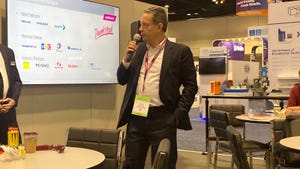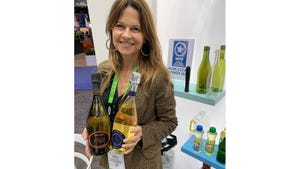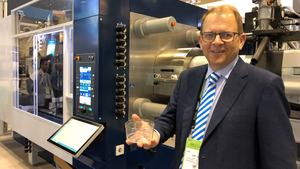Telectronics and the Injection Moulder
January 1, 1997

A look at global sourcing and the state of European parts manufacture for the burgeoning industry known as telectronics.
Telectronics is a relatively new word invented to cover an industry which has seen enormous and at times explosive growth during the last 10 years. It covers a whole range of items which these days we almost take for granted in our domestic and business lives, such as televisions, VCRs, computers, printers, fax machines, photocopiers, telephones, mobile telephones, pagers, and answering machines.
Market Drivers
The growth of this market is driven by a number of factors:
The need for faster, more efficient working methods - the globalization of business dealings and transactions means that successful organizations must be able to transmit and receive messages and information 24 hours per day.
Increased travel and mobility of people both in their personal and professional lives.
Increased interest in new technology - these days people are generally more exposed and better informed about new technologies and the latest gadgets.
The pace of change - new products are constantly being introduced and are evolving at a faster rate. In order to stay ahead, we want the latest model, which we perceive will give us the maximum benefit both now and in the future.
The rise in consumerism - more and more people feel there is a need to have such products. The penetration of telephones and televisions is almost 100 percent in the West and many homes now have two, three, or even four telephone handsets and televisions. Likewise, VCR, mobile telephone, computer, printer, and answering machine ownership has seen a rapid rise, worldwide. These markets continue to expand.
What's Happening in Europe?
Western Europe has seen considerable investment in the telectronics industry both from its own indigenous companies and from overseas corporations. Investment from abroad started with original equipment manufacturers (OEMs) from North America and was followed by companies from Japan and more recently from Korea. Companies with their bases in Hong Kong and Taiwan have also played a role.
European-owned organizations such as Alcatel, Siemens, Nokia, and Ericsson have all invested heavily in this sector. However, the effects of foreign corporations have had a profound impact with Motorola, Hewlett-Packard, IBM, Compaq, and Digital of the USA; Mitsubishi, Matsushita, Sony, and Sanyo of Japan; and Daewoo, Samsung, LG, and Hyundai of Korea being just a few examples.
 The primary country of focus for investment in the west European telectronics industry has been and continues to be the United Kingdom, although Spain is also a strong area. Within the United Kingdom, the key geographic areas are Scotland, South Wales, and the Northeast of England. Government grants, strong proactive regional agencies, an increasingly skilled workforce, favourable labour rates, lower taxes, an open economy, and the English language and culture have contributed to the growing success of this sector. All the aforementioned companies and many others have invested in transplant manufacturing or assembly factories in the United Kingdom.
The primary country of focus for investment in the west European telectronics industry has been and continues to be the United Kingdom, although Spain is also a strong area. Within the United Kingdom, the key geographic areas are Scotland, South Wales, and the Northeast of England. Government grants, strong proactive regional agencies, an increasingly skilled workforce, favourable labour rates, lower taxes, an open economy, and the English language and culture have contributed to the growing success of this sector. All the aforementioned companies and many others have invested in transplant manufacturing or assembly factories in the United Kingdom.
In-house Manufacture vs. External Sourcing
Plastic injection moulded parts and components play a vital role in the manufacture and assembly of finished telectronic products and in establishing a transplant factory. The OEM has to decide whether he will produce in-house or source externally. The situation varies widely.
In some cases, it will be a question of company policy that the OEM will produce some or most injection moulded parts in-house in order to retain better control over product quality or to protect a proprietary technology. In others, it may be more convenient and more cost-effective to outsource components and do only final assembly.
For example, Hitachi has injection moulding equipment to produce a proportion of its television housings within its own factory. Onwa produces all its TV cabinets on the premises, while IBM moulds in-house all its keyboard housings and some of its computer monitor housings. Motorola, Sony, Sanyo, Matsushita, and Mitsubishi, in contrast, have all plastic injection moulded parts manufactured externally.
The telectronics industry may be considered as a global industry, as the sourcing of parts may take place from all corners of the world. Much-reduced production costs can outweigh potentially costly shipping charges. Despite having to ship over long distances, it is often advantageous to source injection moulded parts or indeed complete finished assemblies from distant countries. Beon sources all TV housings and components from Hong Kong.
Microvitec, which produces computer monitors, has some housings made in Thailand. The bulk of Aiwa's VCR housings are made in Malaysia, while a proportion of those for Daewoo in Northern Ireland come from Korea. Nortel sources some of its larger telephone terminal housings from Canada.
Foreign Injection Moulders Investing in the UK
An interesting development has been the establishment of production units of overseas injection moulders in the United Kingdom. This has occurred particularly with the Japanese injection moulders and in certain cases with Korean and North American injection moulders. In view of their long-term relationships with the OEMs and their tried and trusted reputation for supplying high-quality products, Japanese injection moulding companies such as Showa Denko, Showpla, and Tsuda have set up bases in the United Kingdom to supply to JVC, Mitsubishi, NEC, Epson, and Sharp.
In a similar way but more recently, Korean injection moulders have established manufacturing units to supply Samsung with parts for microwave ovens and TVs. However, there are now clear indications that several indigenous moulders have attained the quality, delivery, and commercial standards demanded of the Japanese OEMs and have succeeded in gaining their confidence, sometimes winning contracts at the expense of their Japanese counterparts.
Competition from within Europe
Although the United Kingdom has been extremely successful in establishing itself as the prime manufacturing and assembly base for telectronic products in Europe, it cannot afford to be complacent. Other countries in Europe also have low manufacturing costs, as well as other incentives in order to appear attractive. These include Spain and Portugal in particular in Western Europe, and Poland in Eastern Europe.
The intra-European competition has an impact both on the OEMs and on the moulders, as they may compete for certain contracts and sectors of the business. Sanyo also has a plant in Spain using local injection moulders. Equally, the Sanyo factory in the United Kingdom sources some its parts from Spanish injection moulders. In addition, the company has an assembly facility in Poland, which sources mouldings from the United Kingdom. Sony has a facility in Spain for the manufacture of TVs. Hewlett- Packard designs and produces monochrome and colour printers at its Spanish factory in Barcelona. Samsung has a joint assembly plant with Texas Instruments, USA, in Portugal for the manufacture of memory chips.
Material Considerations
Few great changes in materials are anticipated in the foreseeable future since parts are already made from the optimum materials currently available. A brief synopsis of materials used for prime telectronic parts follows:
Televisions - Cabinets use HIPS with flame retardancy ratings varying from V-0 (the most stringent) to HB (the least stringent). Standard integrated speakers also use HIPS but where a higher acoustic performance is required, such as on Dolby sound systems, the speakers will be made from PP. Smaller portable TVs often use ABS, which may be self-coloured.
VCRs - Chassis front panels and cassette doors use HIPS, which is generally HB rated. Buttons use ABS while display panels use PMMA or a PMMA blend.
Computer monitors - the main housings may be made from HIPS (V-0), flame-retardant ABS, a PC/ABS blend or PVC, the latter being IBM's preferred material.
Computer CPUs - the chassis is made of metal for shielding reasons, but front bezels and rear bezels where they occur are made from PC/ABS.
Keyboards - housings are constructed from PVC or flame-retardant ABS.
Printers - Main chassis parts are made from HIPS, PPO, PC/ABS or glass-reinforced PC/ABS, depending on the part. The HIPS may be V-0 or HB rated depending on the part's proximity to the power source.
Telephone terminals use ABS, usually with antidust and antisqueak properties. High-gloss or low-gloss grades for a matte, textured finish may be chosen.
Mobile telephones - most manufacturers use a PC/ABS blend for the main housing parts. Motorola is the exception; it tends to use pure PC, which can be more difficult to handle with thin-wall mouldings.
Pagers, like mobile telephones, use a PC/ABS blend for most parts with PC for the window display.
Issues Facing Telectronic Injection Moulders
Injection moulders serving the prestigious and technical telectronics industry should be aware of a number of factors impacting upon this dynamic sector:
The need to be current with new materials and new technologies. High-flow polymers will play a greater role, especially in moving towards thinner wall housings. Gas-assist injection moulding is used to produce lighter parts, and the use of hot runner systems will increase to reduce waste, improve cosmetic appearance, facilitate colour change, and give faster cycle times.
Working in partnership. In the telectronics sector, OEMs, polymer producers, moulders, and suppliers of other components must work closely together to ensure that the optimum product is developed in the most cost-effective way. Regular meetings are often held between the OEMs and their suppliers, often at headquarters or the Design Center where control of the product is maintained.
Faster development time to new product launch. In order to remain competitive, the OEMs must use the latest technology and have the latest version available on the market. The development time for both the OEM and the moulder must therefore be very swift. Injection moulding companies will need to consider whether they wish to be involved in fast-changing, design-oriented markets or in the slower-moving, less design-oriented markets. Additionally, the trend towards miniaturization will give rise to smaller, more compact units as may be the case with digital video disk technology.
Greater responsibility with the moulder. As has happened in the automotive industry, suppliers to the telectronics sector are generally expected to do far more than merely supply a raw injection moulded part. Thus, most injection moulders are required to do a degree of painting and subassembly, such as attaching smaller components, buttons, badges, and logos.
Total quality. This continues to play a key role as the OEMs strive for the minimum defect rate.
Increased size of the moulders. To cope with the expansion of the telectronics industry in the United Kingdom, injection moulders are having to extend their facilities. Caradon Elliot established a new moulding facility for computer monitors. McKechnie is enlarging the South Wales facility to make computer monitors.
Shortage of skilled personnel. The rapid rise of the telectronics industry in the U.K. has meant there is an insufficiently large skilled and experienced workforce on hand. It is an employees' market and incidences of staff switching from one telectronics company to another in the same area are not uncommon. In order to build up a satisfactory skills base in the South Wales area, for example, a training center for the semiconductor industry is being established. The aim is to provide training for technicians, process engineers, and post graduates.
It is evident that the fast-growing telectronics industry presents many varied opportunities to the injection moulder. Those companies with the greatest chance of success will be those with firm objectives, a clearly defined strategy, and full awareness of the technical and commercial implications.
Contact Information: The telectronics industry in the United Kingdom will be the subject of a market study by Applied Market Information Ltd. to be published in early 1997. For more information about the upcoming study, contact: AMI House Alison Cockrell 45-47 Stokes Croft Bristol BS1 3QP, U.K. Phone: (44) 117 9249442 Fax: (44) 117 9892128 e-mail: [email protected]. Web site: http://www.amiplastics.co.uk/ami/
You May Also Like


